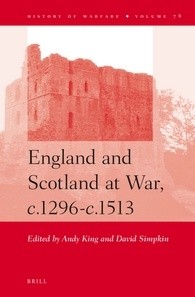 Reviewer: Wouter van Dijk
Reviewer: Wouter van DijkEngland and Scotland at War, c.1296-c.1513, Andy King and David Simpkin, editors
Brill Academic Publishers, Leiden-Boston 2012
ISBN: 978 90 04 22982 2
Series and volume number: History of Warfare, volume 78
Hardcover With bibliographical references and index
409 pages
€ 158,00
Anglo-Scottish warfare during the Middle Ages
Some months before the 500-year commemoration of the Battle of Flodden of 1513, Andy King, Research Fellow in History at the University of Southampton and David Simpkin, Honorary Visiting Fellow at the University of Reading, published this many-sided collection of essays concerning the numerous medieval border conflicts between England and Scotland. As King and Simpkin explain in their introduction, the writing of military history requires a many-sided approach, and that is exactly what they have set out to deliver with this publication. Besides giving a preface of the fourteen more or less chronologically arranged essays of which this book consists, in their introduction King and Simpkin justify their publication by answering the question what a study of Anglo-Scottish warfare has to offer to the field of military history. According to King and Simpkin, as a typical border region, studying the medieval Anglo-Scottish conflicts is an excellent way to gather knowledge about the impact of warfare on border regions and the inhabitants of those areas. Also, because the richness of available source material such as wardrobe books and chronicles, mostly on English side, these conflicts make a very useful case study of medieval warfare. Studying the border wars between Scotland and England also offers good possibilities to outline varieties between the two different martial cultures, societies and institutions over a longer period of time. The complexity of this long research period of roughly 200 years lies in the variability of many factors, such as variations in the English and Scottish internal situations during different periods of conflict and peace, the amount of defensible men the two kingdoms could muster and the alteration of the international situation. In my review I will treat several articles in the book that form, in my opinion, a good cross-section of the collection while showing the broadness of treated subjects in the volume.
After their introduction, in which King and Simpkin discuss some historiographical issues concerning medieval Anglo-Scottish warfare and the usefulness of the ‘military revolution’ debate in this research area, the bundle opens with an article on the place of the Anglo-Scottish conflict in English chronicles with special focus on the role of Edward I. The author, Thea Summerfield looks at different chronicles and concludes, not very surprisingly, that in most of the English-based chronicles the focus is definitely not on Scottish affairs but more on international matters, such as the participation of Edward I in the Ninth Crusade. A notable exception on this rule is Langtoft’s Chronicle, in which references to the Scots and war with the Scots are numerous. Andrew M. Spencer follows with a very interesting article in which he tries and succeeds to nuance the public image of John de Warenne and the way he went down in history as an utter failure. John, earl Warenne, was Guardian of Scotland and commander of the English royal forces at the Battle of Stirling Bridge in 1297. After his defeat at the hands of Wallace and Murray he was blamed for his bad leadership in the campaign that led to the battle and the battle itself. Spencer shows that despite the faults of Warenne, the defeat at Stirling was not due to him alone. Although he underestimated the strength of the forces under Wallace’s and Murray’s command, the preoccupation of Edward I with the conflict in France was not very helpful in ending the resistance in Scotland firmly.
Besides contributions concerning the conduct of warfare itself, the book also contains articles on the commemorative culture around the Battle of Flodden, military leadership, and the bureaucratic and administrative side of waging war in medieval England and Scotland. Ethnicity, so-called ‘proto-nationalism’ and the question concerning allegiance to the English or Scottish crown also receive a fair share of attention, as there are essays to be found about the special position English Lothian played in the wars, the place of the Highland Scots in Anglo-Scottish warfare and even a case-study of the switching loyalty of Scottish noblemen serving either of the two crowns, in this case focusing on Sir Ingram de Umfraville. Besides the case of shifting allegiances of Sir Ingram de Umfraville, switching loyalties are also the subject of Iain McInnes’ contribution, in which he focuses on loyalties of the Scottish nobility and clergy. McInnes makes good use of the richness of information that can be found in the Calendar of Documents relating to Scotland and delivers new insights on the question of loyalty under the Scottish clergy in his research period; 1334-1337. Contrary to what is sometimes suggested, McInnes makes clear that the loyalty of the Scottish clergy in this period generally did not lie with the Scottish king David II, but rather with the English king, which most church officials saw as a safer way to protect their interests and possessions.
Some of the articles generate conclusions that are perhaps not surprising, as is the case with Jonathan D. Gledhill’s essay on the position of Lothian in the Anglo-Scottish wars. Gledhill states that in Lothian there remained much support for Edward I, until the Battle of Bannockburn in 1314 and the subsequent evacuation of English border garrisons such as Berwick. Illustrating this by providing an analysis of the situation of many local magnates and their allegiance, Gledhill concludes that their loyalty shifted with the changing of military dominance in the region. Before 1314, the English were dominant, after 1314 Robert Bruce and his supporters were. Despite this somewhat obvious conclusion, the well-researched and clear account is very helpful to substantiate this assumption. An article with some interesting outcomes is the contribution of Steve Boardman about Highland Scots and their part in the Anglo-Scottish border conflicts. Boardman in his article tries to disprove the assertion that is made by some scholars that Highland Scots were hardly involved in the fourteenth- and fifteenth-century wars against England. To achieve this he scrutinizes a variety of medieval annals, chronicles and accounts and at the same time describes the relation of many Highland Lords with the successive kings of Scotland during this period. Boardman demonstrates not only the widespread and active involvement of a large number of Highland Scots in the English wars but also that the Gaelic-speaking Highland Lords were part of the inner circle around the king at the end of the fourteenth and the beginning of the fifteenth century.
As is said, it would be too much to discuss every single article of this rich volume on medieval Anglo-Scottish wars; therefore, some final remarks on the complete collection of contributions contained in the book are in order. It is clear that a large amount of research has preceded the writing of every single contribution in this collection, and that sure makes them all worth reading, despite the somewhat lengthy writing style of some of the authors. The incredible broadness in range of subjects and wealth of perspectives offered by the different articles makes this collection of essays a very valuable complement to the existing amount of research concerning the subject. The researcher of medieval Anglo-Scottish warfare will find in this volume article after article to his liking, therefore this collection of essays is very highly recommendable for the advanced scholars of the subject. For those with an average interest in Scottish, English or medieval history the subjects of the contributions will often prove too specialist. The reader needs a lot of knowledge of medieval English and Scottish history as well, therefore this book is not to be recommended to those with just a broad interest in medieval history, but rather to the adept or professional scholar of medieval warfare or the Anglo-Scottish conflicts of this period, for whom this volume will prove to be an extraordinary asset in his or her collection.
Reading this skilfully written and up-to-date overview of the current state of research on Anglo-Scottish medieval warfare, it becomes clear to the reader that the inheritance of authorities on the subject as Geoffrey Barrow and Michael Prestwich is in safe hands.
Wouter van Dijk
